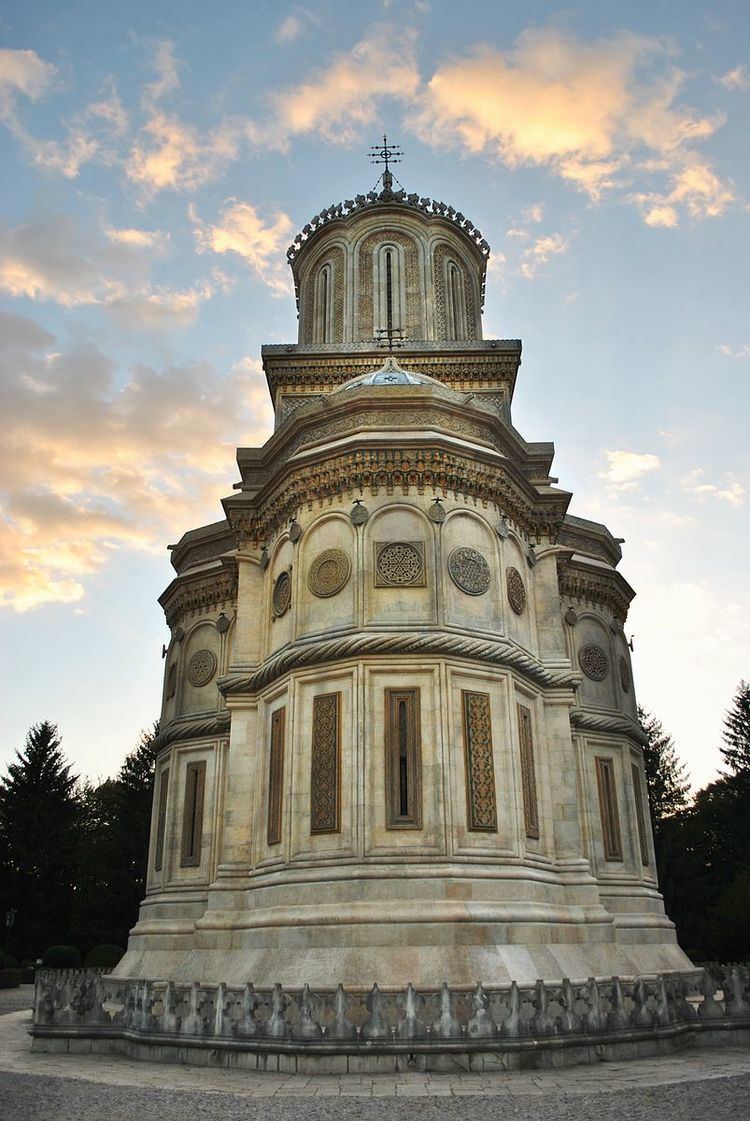Year consecrated 1886 Status Active Region Wallachia | Phone +40 248 721 735 | |
 | ||
Affiliation Eastern Orthodox Church Address Bulevardul Basarabilor 1, Curtea de Argeș 115300, Romania Architects Meșterul Manole, Nicolae Gabrielescu Burials Marie of Romania, Radu of Afumați, Elisabeth of Wied, Queen Anne of Romania Similar Lake Vidraru, Vidraru Dam, Poenari Castle, Mănăstirea Corbii de Piatră, Mănăstirea Nămăești | ||
M n stirea curtea de arges 26 decembrie 2014 by geo
The Cathedral of Curtea de Argeș (early 16th century) is a Romanian Orthodox cathedral in Curtea de Argeș, Romania. It is located on the grounds of the Curtea de Argeș Monastery, and is dedicated to Saint Nicholas. The building is the seat of the Archdiocese of Argeș and Muscel.
Contents
The cathedral is faced with pale grey limestone, which was easily chiselled then hardened on exposure. The interior is of brick, plastered and decorated with frescoes. Nearby on the grounds stands a large Moorish-style royal palace.
Architecture
The building resembles a very large and elaborate mausoleum, and was built in the Byzantine style, with Moorish arabesques. The cathedral is upon a raised platform, 7 ft (2.1 m) above the surrounding grade, and encircled by a stone balustrade. In shape the structure is oblong, with a many-sided annex at the back. A dome rises in the center, fronted by two smaller twisting and leaning cupolas, while a secondary dome, broader and loftier than the central one, springs from the annex. Each summit is crowned by an inverted pear-shaped stone, bearing a triple cross, emblematic of the Trinity.
The windows are mere slits; those of the tambours (the cylinders on which the cupolas rest) are curved and slant at an angle of 70 degrees, as though the tambours were leaning to one side.
Between the pediment and the cornice a thick corded moulding is carried round the main building. Above this comes a row of circular shields, adorned with intricate arabesques, while bands and wreaths of lilies are everywhere sculptured on the windows, balconies, tambours and cornices, adding lightness to the fabric.
Facing the main entrance is a small open shrine, consisting of a cornice and dome upheld by four pillars.
Inscriptions
The archives of the cathedral were plundered by Hungarians and Turks, but several inscriptions, Greek, Slav, and Roman, are left.
One tablet records that the founder was Prince Neagoe Basarab (1512-1521); another that Prince Ioan Radu completed the work in 1526; a third describes the repairs executed in 1681 by Prince Șerban Cantacuzino; a fourth, the restoration, in 1804, by Joseph, the first bishop. Between 1875 and 1885 the cathedral was reconstructed, and in 1886 it was reconsecrated.
Legends
Legends of Curtea de Argeș have inspired many Romanian poets, among them the celebrated Vasile Alecsandri. One traditional legend describes how Neagoe Basarab, while a hostage in Constantinople, designed a splendid mosque for the sultan, returning to build the cathedral out of the surplus materials.
A legend tells of Radu Negru employing a Meşterul Manole or Manoli as architect. With Manole being unable to finish the walls, the prince threatened him and his assistants with death. At last Manole suggested that they should follow the ancient custom of placing a living woman into the foundations; and that she who first appeared on the following morning should be the victim. The other masons warned their families, and Manole was forced to sacrifice his own wife. Thus the cathedral was built.
When Manole and his masons told the prince that they could always build an even greater building, Radu Negru had them stranded on the roof so that they could not build something to match it. They fashioned wooden wings and tried to fly off the roof, but, one by one, they all fell to the ground. A spring of clear water, named after Manole, is said to mark the spot where he fell.
This motif is widespread in South-East Europe, most notably also in Russia, like the blinding of the Masons of Saint Basil's Cathedral by Ivan the Terrible.
